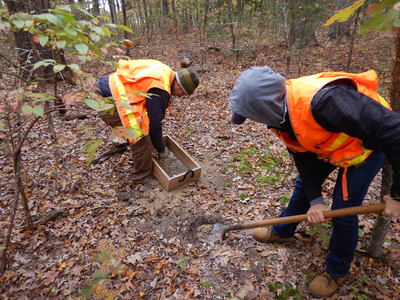Several of the 200 known archaeological sites along the Middle Peninsula and Northern Neck are prehistoric—dating from as early as 9,000 years ago.
Determining how threatened these precious artifacts are from storm effects and shoreline erosion is the job of several Longwood University anthropology students and alumni, who have finished the initial stages of this critical work and are now ready to move into field research.
The archaeological sites—in Mathews and Middlesex counties on the Middle Peninsula and Lancaster and Northumberland counties in the Northern Neck—range from prehistoric to early 20th century. Led by the Longwood Institute of Archaeology and in collaboration with the Virginia Department of Historic Resources and funded through the National Park Service, students will conduct a shoreline analysis to determine erosion rates and the impact of that erosion on known archaeological sites. They’ll also work on a predictive model to identify locations where there is a high probability of unknown sites.
"This is a fantastic opportunity for our students to become immersed in field research that will produce tangible data on the state of archaeological resources along the shore in these communities," said Dr. Brian Bates, the institute’s executive director. "One of the key reasons that the Institute of Archaeology was formed was to provide our students with real-world, practical experience on a level that is unheard of at the undergraduate level. This project does this perfectly."
The Longwood Institute of Archaeology was founded in September and employs three full-time professional archaeologists in addition to Bates.
The upcoming work will be extensive—once the analysis and modeling is complete, students and institute staff will record the current state of preservation and threat for each site, producing a valuable inventory of threatened sites along with a forecast predicting when a site will be destroyed by erosion. That’s powerful information as local communities and state resource managers decide how to recover information about these historic assets before they are lost forever.
For Longwood students, the benefits are wide-ranging. Students will not only play an integral role in developing archaeological information that is useful in the real world, but also work with the local communities to inform them about project details and enlist community members to engage with the work. Those are valuable skills for any archaeologist as he or she prepares to enter the workforce.
"We teach students to not only possess the skills necessary to do the job, but also be mindful of the communities they are working in," said Bates. "Every site is different and because our work touches so many people, there are a lot of varied concerns and perspective. Putting students in the position where they can be guided through this process gives them valuable experience they can apply as they enter the workforce. All the while, they’re gaining critical field skills as they catalog and analyze these precious artifacts of our state history."
In the coming months, the Longwood team will conduct intensive fieldwork at the known sites and reach out to local communities to give updates on progress and solicit valuable feedback.
[Related Video: About the Longwood Anthropology Program]



Leave a Comment